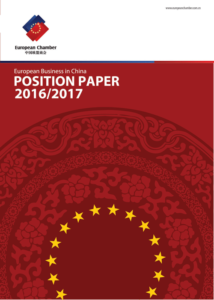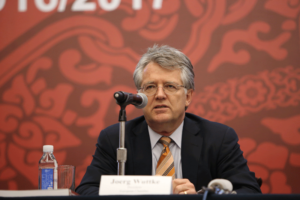The launch of the Chamber’s Position Paper 2016/2017
On 1st September, the European Chamber launched our European Business in China Position Paper 2015/2016, in advance of the G20 summit in Hangzhou. This year’s paper evaluates the ramifications of the 13th Five-Year Plan (13FYP) for European business. It also appraises the China Manufacturing 2025 initiative, a plan that seeks to comprehensively upgrade China’s manufacturing industry, the key themes of which are echoed throughout the 13FYP. The Executive Position Paper aims to distil the essence of the 21 vertical and 11 horizontal papers, to provide macro-level commentary and policy recommendations to China’s policy-makers as to how the country can continue its impressive economic growth in the spirit of the Third Plenum’s Decision. It also highlights how recommitting to reform will enable China to transition to a more sustainable growth model, as aspired to in the 13FYP.
The 13th Five-Year Plan (13FYP)
Having reviewed the 13th Five-Year Plan (2016–2020) (13FYP), the European Chamber has two questions:
- Will the Chinese leadership live up to its commitments to allow market forces to play the decisive role in the economy?
- Will European business be given more room to participate in and contribute to China’s next stage of economic development?
Any response other than a firm ‘yes’ to either question would be detrimental to China’s economy.
An increasingly strong role for the government in developing industries by directing capital into sectors that central planners have established as priorities will not allow China to realise its full economic potential.
While government undoubtedly has an important role to play in supporting basic research and establishing a mature regulatory framework, it is private businesses and investors that should be developing new technologies – they have the clearest understanding of their own industries and make decisions in response to market forces. Open markets and more private investment—with the efficiencies and increased capacity for innovation that they bring—are essential if China is to fulfil its promise and avoid getting stuck in the middle-income trap.
With growth rates of investment in China by privately-owned enterprises (POEs) having declined from 10.1 per cent in 2015, to 2.8 per cent during the first half of 2016, providing POEs with better market access would certainly help to alleviate some of the country’s immediate economic challenges while restoring some investor confidence. And as China will be the primary benefactor of further domestic market opening, doing so is very much in its own interests.
 Follow Through on Reforms to Date
Follow Through on Reforms to Date
It is not yet clear how the state-centric focus of the 13FYP and the China Manufacturing 2025 (CM2025) initiative fit with the overall reform agenda that was announced at the Third Plenum – the Decision seeks to reduce the role of government in the economy, not expand it. While there has been some progress,[1] the fact that most of the Decision is yet to be implemented is highly disappointing, especially as many Chinese officials and businesspeople were initially encouraged by its content, viewing it as a genuine statement of intent. Following through on this reform plan would enable China to make the changes to its economic model that are now necessary.
The publication in the Party’s official newspaper in May 2016, of an interview with an unnamed ‘authoritative person’ on the state of China’s economy—whose views are believed to align with those of President Xi Jinping and his senior economic advisors—indicates that there are senior officials who clearly understand the challenges that China currently faces. However, actions speak louder than words. As reforms that expand market access for private business, including European business, are clearly part of the solution, deferring actions until after the 19th Party Congress in late 2017 is unnecessary and would result in significant costs.
An Unequal Investment Landscape
There have already been enormous investment flows from China into Europe in 2016. This is welcomed for the jobs and economic growth that it creates. However, due to the clear lack of reciprocity in market access, it also serves to highlight the many areas where European business is prohibited, or at best restricted, from making similar investments in China. This unbalanced situation is not politically sustainable and for its own benefit China should begin reciprocating by opening up and allowing European business to contribute more to its economy. As China needs the EU as much as the EU needs China, it is expected.
This is why concluding a robust EU-China Comprehensive Agreement on Investment (CAI) that includes an ambitious market-opening component is so important for ensuring that EU-China economic relations reach their full potential – it must allow for full reciprocity. The European Chamber therefore hopes that negotiations for the CAI will be concluded before it publishes its annual position paper in 2017.
Conclusion
European business continues to hear reform commitments aimed at affording FIEs more market access, as well as statements attesting to their importance to the Chinese economy.[2] As welcome as these are, they have been heard before: it is hoped that the importance of pairing words with actions will now be recognised.
With global economic growth remaining fragile, both China and the EU will suffer if China does not reach its full potential. In the interests of mutual prosperity, European business wants China to succeed. The European Chamber can therefore only continue to advocate for the necessary market-orientated reforms to be pushed through, without delay.
Download the Position Paper 2016/2017 here.
[1] The European Chamber’s Position Paper 2015-2016 contained a ‘reality check’ of the Decision. Working groups awarded green lights to indicate reform successes (10%), amber lights to indicate partial progress (66%) and red lights where little or no reform progress, or even deterioration, had been observed (24%).
[2] For one recent example: Zhao, Huanxin, Li to Open Investment Door Wider, China Daily, 29th June, 2016, viewed 29th June, 2016, <http://www.chinadaily.com.cn/business/2016-06/29/content_25894389.htm>



Recent Comments